
Rayxanber is a 1990 scrolling shooter video game developed and published by Data West for the FM Towns. It is the first entry in the Rayxanber series, followed by Rayxanber II (1991) and Rayxanber III (1992) for the PC Engine platform. In the game, the player assumes the role of a fighter pilot from Earth controlling the RT-X-32 space craft to fight against the biomechanical Zoul Empire. The title was created by Team 50, a group within Data West. The soundtrack was scored by Yasuhito Saito, who composed for other titles such as Layla and The 4th Unit series. It garnered mixed reception from critics.

Viewpoint is an isometric-scrolling shooter arcade game developed by Aicom and originally released in 1992 by Sammy and SNK for the Neo Geo hardware family. The arcade version was met with critical acclaim upon release for its cutting-edge visuals and hip hop-influenced soundtrack, though later ports for the Sega Genesis and Sony PlayStation saw much more mixed reviews.
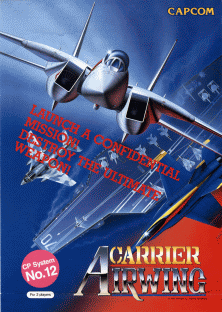
Carrier Air Wing, released in Japan as U.S. Navy, is a 1990 side-scrolling shooting game released for the CP System arcade hardware by Capcom. It is the spiritual successor to U.N. Squadron, which was released in the previous year. As with the original, players chose any one of three different jet fighters and battle their way through ten enemy-packed stages. Other ideas carried over from U.N. Squadron include the shop, which allows players to buy weapon and shield upgrades for their jet fighter between stages, and the energy bar, which is replaced by a "fuel bar" which starts full at the start of each stage and decreases as time passes with some fuel lost each time the plane is damaged. The game has two different endings, depending on whether the game is finished with only one coin or not. A version for the Capcom Power System Changer was planned and previewed but never released.

Rally Bike is a racing arcade video game originally developed by Toaplan and published by Taito in May 1988. In Rally Bike, players compete against computer-controlled opponents in races across locations in the United States. Initially released in arcades, the game was ported to the Nintendo Entertainment System and X68000 by different developers.
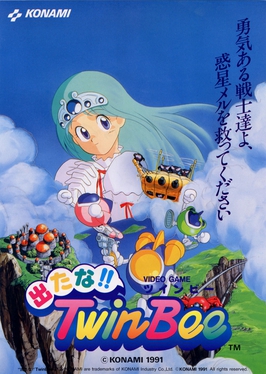
Detana!! TwinBee, released in Europe and North America as Bells & Whistles, is a 1991 vertically scrolling shooter arcade video game developed and released by Konami. It is the fifth entry in the TwinBee series and the second to be released for arcades following the original TwinBee. Set several years after the events of TwinBee, players assume the role of Light and Pastel taking control of TwinBee and WinBee to defeat invading forces of the evil alien Iva and save planet Meru after receiving an SOS message sent by Princess Melora.

Valis II is a 1989 action-platform video game originally developed by Laser Soft, published by Telenet Japan and NEC for the PC Engine CD-ROM²/TurboGrafx-CD. A home computer version was released for PC-8801, MSX2, PC-9801 and X68000. A super deformed-style remake was also released in 1992 for the Sega Mega Drive/Genesis. It is the second entry in the eponymous series. It stars Yuko Asou, a Japanese schoolgirl teenager chosen to become the Valis warrior by wielding the titular mystical sword, after defeating the demon lord Rogles. The dream world Vecanti fell under the rule of emperor Megas, whose hatred towards his brother Rogles and bloodthirsty tendencies seeks to wipe out traces of the former tyrant, including his supporters. Gameplay varies between each version but all share similar elements, as the player explores and search for items and power-ups, while fighting enemies and defeat bosses.

Varth: Operation Thunderstorm is an arcade game in the vertical scrolling shooter genre, published by Capcom in 1992. The game did not see a console port following its initial release, but 14 years later Digital Eclipse Software would port the game onto the PSP handheld, and later onto the PlayStation 2 and Xbox.

Jewel Master (ジュエル・マスター) is a 1991 video game for the Mega Drive/Genesis game console. It takes place in the country of Mythgard, where the protagonist, The Jewel Master must traverse the harsh lands ranging from scorching deserts to rugged mountains and through long forgotten ruins to collect the 12 elemental rings and save Mythgard from the clutches of the Demon King, Jardine the Mad.

Granada is a shooter video game developed and originally published by Wolf Team exclusively for the X68000 in Japan on 20 April 1990. The ninth title to be created and released by Wolf Team for the X68000 platform, the game is set on a futuristic Africa in 2016 where a war erupted over mining rights towards rare metals and has quickly escalated due to newly-introduced weapons called Maneuver Cepters, as players assume the role of mercenary Leon Todo piloting the titular Maneuver Cepter tank unit in an attempt to stop the conflict once and for all. Its gameplay mainly consists of action and shooting mixed with mission-based exploration using a main two-button configuration.
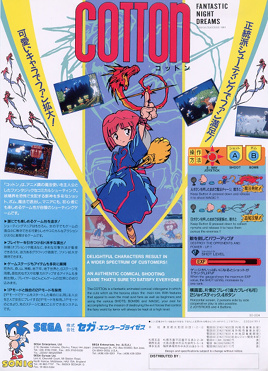
Cotton: Fantastic Night Dreams is a scrolling shooter video game developed by Success and originally released in Japanese arcades in 1991. The first installment in the Cotton series, players assume the role of the young witch Cotton who, alongside her fairy companion Silk, sets out on her broomstick on a quest to defeat several monsters and get her Willow candy. Its gameplay mainly consists of shooting mixed with role-playing game elements using a main two-button configuration. It ran on the Sega System 16 hardware.
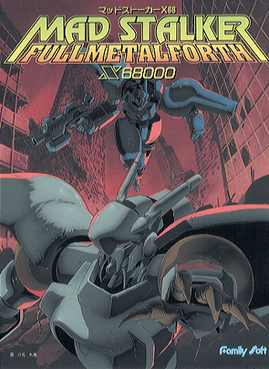
Mad Stalker: Full Metal Forth is a 1994 side-scrolling beat 'em up game developed by Fill-in-Cafe and published by Family Soft in Japan for the X68000. It is the fourth game to be created and released by both Fill-in-Cafe and Family Soft for the X68000 platform late into its commercial life span, after being discontinued in 1993.
Takeru, also known as Sur Dé Wave, was a Japanese video game developer.

Geograph Seal is a first-person mecha platform-shooter video game developed and published by Exact exclusively for the Sharp X68000 in Japan on March 12, 1994. The fourth and last title to be created and released by Exact for the X68000 platform late into its commercial life span, after being discontinued in 1993 by Sharp Corporation with the last model launched, it is widely considered a spiritual predecessor to the Jumping Flash! franchise by Sony Computer Entertainment.

Étoile Princesse is an action role-playing video game developed and published by Exact exclusively for the X68000 in Japan on March 26, 1993. It is the third title to be created and released by Exact for the X68000 platform late into its commercial life span, which was a few months before being discontinued in the same year by Sharp Corporation.
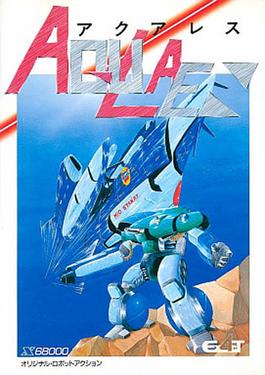
Aquales is an action role-playing run and gun video game developed and published by Exact exclusively for the X68000 in Japan on September 12, 1991. The second title to be created and released by Exact for the X68000 platform, the game takes place in the dystopian future of 2069 where the British Elias-Rits Investigative Unit ship went missing during a reconnaissance operation at the Kermadec Islands, as players assume the role of American pilot Fredric von Nyuya from the elite World-Ocean Development League squad taking control of a mecha in an attempt to unveil the truth behind the mysterious disappearance of the Elias-Rits embarkation during their operation. Its gameplay mainly consists of action and shooting mixed with mission-based exploration, as well as role-playing elements, using a main two-button configuration.

Undeadline is a 1989 vertically scrolling shooter video game developed and originally published by T&E Soft for the MSX2 and MSX2+ home computers. It was later ported to the X68000 computer and Sega Mega Drive, published by Palsoft, followed by digital re-releases for Microsoft Windows. Both the MSX2 and X68000 versions also received physical re-releases by Japanese retailer BEEP. It follows a group of characters in rescue of queen Althea from Zidane, a kingdom surrounded by barriers connected with the demon world, whose monsters have overflowed it. Controlling either a fighter, wizard, or ninja, the player can choose from six stages and play them in any order, fighting against waves of enemies and bosses, while defending or avoiding collision with their projectiles and other obstacles.
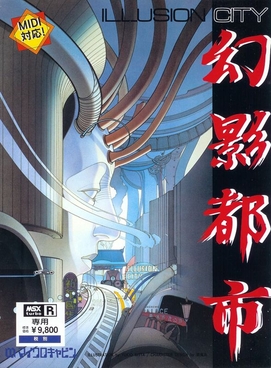
Illusion City is a role-playing video game originally developed and published by Microcabin for the MSX Turbo R home computer. It was later ported to PC-88 and PC-98 computers, FM Towns, X68000, and Sega Mega-CD. The story takes place in the 21st century after Hong Kong was devastated by a demonic attack, before the crisis was isolated and the region was reformed under new order by SIVA corporation. The game follows demon hunter Tianren, gathering information in order to unravel the mystery surrounding the demonic beings and SIVA corporation. Gameplay features a growing party led by Tianren navigating the city, talking with non-playable characters, exploring complex areas, and taking part in turn-based battles against enemies.

Namachūkei 68 is a 1991 sports video game developed and published by Konami for the X68000. In the game, players have the choice to compete in matches against computer-controlled opponents or other human players in either a single game or a full season. The players selects between 12 teams that come with the game, but can also create their own team as well as manage the statistics of each individual player. Gameplay incorporates multiple camera angles to present a pseudo-3D perspective, in a manner resembling a sports television broadcast.


















